Warning signs
|
The elk warning signs are very popular: Foreign tourists steal them and local hunters (?) use them as shooting targets. You had better take these signs seriously, though. Up to 800 kilograms of long-legged animal through the windscreen is kind of overwhelming. Notice also that they usually – but not always! – flee from people (or "hide" behind a tree), but like other animals they're not afraid of cars. This is the Eurasian Elk – Alces alces (or machlis). The Americans call it moose because it looks like its American slightly larger and more aggressive relative – Alces americanus (or the Alaskan Alces gigas), and because in America elk is a large deer also called wapiti (Cervus canadiensis). |

|
|
The Red Deer (Cervus elaphus) is also quite big, the stag may reach about 250 kilograms. They are not so well adapted to cold winters as elks, so they live mainly in coastal areas of Southern Norway (and most of Central Europe). [The elegant Roe Deer, weighting less than 35 kilograms, also live in Southern Norway (and Central and Southern Europe). If one of them leaps across the road, its mate is usually close behind. There is no warning sign for them.] |

|
|
Wild reindeer are too shy to approach a road, therefore this sign concerns the domesticated ones. They are found mainly in the northern parts of Norway from Trøndelag and up. Driving through the highlands of Southern Norway you may also come across one of those commercial "Lapp camps", often displaying a reindeer with beautiful antlers. In Norway wild reindeer live only on Hardangervidda and Dovrefjell–Sunndalsfjella, both are highlands of the southern part. The species living here is Rangifer tarandus, subspecies tarandus. There are totally seven (non-extinct) subspecies of reindeer, three in Eurasia (including the small one on Spitzbergen) and four (Caribou) in North America. |

|
|
This sign is usually seen where a farmer occasionally drives his cattle across the road. On some minor roads cattle may also move freely, and they are damned stubborn. A car, however big or fast, doesn't impress them. Neither does the horn (the automobile's). Don't worry though, the cows are aggressive towards us, and they – in their sluggish way – obey people. However, be careful if you bring a dog as it may be attacked by the whole herd. Which may become quite ugly; after all, a cow weights half a metric ton. |

|
|
The sheep-and-lamb sign is really cute. When lambs are frightened by an approaching car, they run to their mother – which is often across the road. In some districts sheep are often seen grazing close to the road or lying on the roadside ruminating. |

|
|
Riding is a popular sport particularly among teenage girls. There are numerous riding schools where you can borrow a horse and take riding lessons. Effectively this sign advertises a riding school. |

|
|
This sign isn't quite official and it isn't quite serious. This sample stands at the foot of Trollstigen, a road virtually climbing a mountain. The sign depicts a troll, one of those Nordic mythical creatures, you know. Trolls are supposed to be frightening and Trollstigen has scared many of its visitors. Thus it is an appropriate warning sign. |

|
|
This sign is deadly serious, but it isn't a road sign – simply because there aren't many roads on Spitzbergen. It warns you of polar bears (ice bears) – never leave the protection of nearby houses (they never lock the doors) without carrying a gun and knowing how to use it. This sign has changed; it used to be a black polar bear on a white background. 
|

|
Humans are also supposed to be animals
– and I feel compelled to complete the series ...
The old versions of these signs (left) are being replaced by new ones. The latter are conventionalized and gender-neutral, which means no hats and no pigtails.
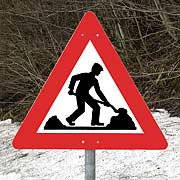
|
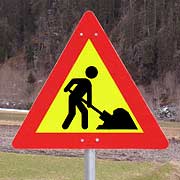
|
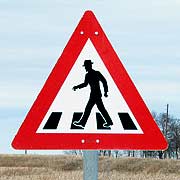
|
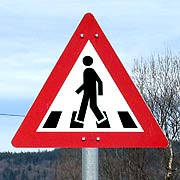
|
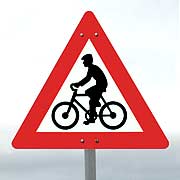
|

|
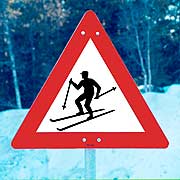
|
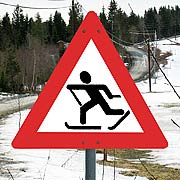
|
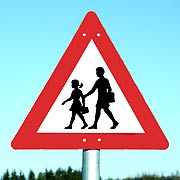
|
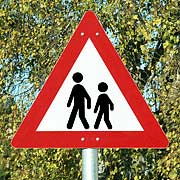
|
Extra below: Children's crossing signs in our neighbour countries Sweden (left) and Iceland. They are not gender-neutral and the female is the dominant one.
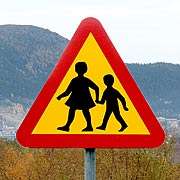
|
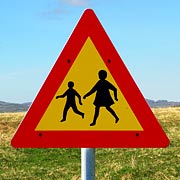
|
